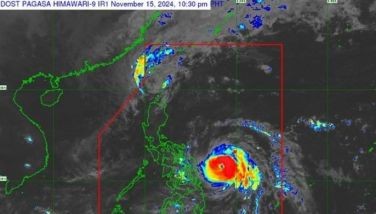China builds more Spratly outposts
MANILA, Philippines - China has set up military garrisons and outposts within Philippine-claimed territory in the Spratly Islands in the South China Sea.
Documents and photographs obtained by News5 show that the military garrisons and outposts are located on six reefs that are part of the Kalayaan Island Group. Brunei, China, Malaysia, the Philippines, Taiwan and Vietnam are claiming the Spratlys either entirely or in part. The Spratly Islands are located within an area of 150,000 square miles and are made up of some 200 islands, reefs and shoals.
The Aquino administration is expected to push for diplomatic solutions to the dispute as well as joint economic development of the area. But a political analyst said Manila should not surrender its sovereignty and should turn to the international community for help.
The Philippines is claiming only a portion of the Spratlys, known as the Kalayaan Island Group, located in a 64,000- square-mile area and made up of 54 islands, reefs, and shoals.
Included in the Kalayaan Group is Pagasa, also known as Thi Tu Island, the second biggest island in the Spratlys. The Philippines has an airstrip and maintains a small community on Pagasa Island as well as garrisons in eight other islets.
Vietnam occupies 23 islets while China and Malaysia occupy seven each.
The Kalayaan Island Group is part of the province of Palawan and is within the 200 nautical mile exclusive economic zone of the Philippines.
Documents show that of the seven Chinese-occupied islands, six are located well within the Kalayaan Island Group. The military garrisons and outposts were located at Kagitingan (Fiery Cross) Reef, Calderon (Cuarteron) Reef, Gaven Reef, Zamora (Subi) Reef, Chigua (Dong Men Jiao) Reef and Panganiban reef, better known as Mischief Reef.
At Kagitingan Reef, China built a permanent communications and maritime observatory garrison that can house 200 troops. China built a helicopter landing pad, a 300-meter long wharf allowing supply ships and patrol boats to dock, a two-storey barracks and a 500-square meter plantation area. Beijing designated the Kagitingan Reef as its main command headquarters as it is equipped with satellite data transmission, surface and air search radars. This garrison is armed with at least four high-powered naval guns and several gun emplacements.
China built permanent reef fortresses and supply platforms at the Calderon, Gaven and Chigua reefs. These supply platforms can resist winds up to 71 knots and are equipped with VHF / UHF communications equipment, search radars as well as naval guns and anti-aircraft guns. These three supply platforms can also serve as docks for Chinese navy patrol boats.
At Zamora Reef, China has built a permanent reef fortress and supply platform that can house 160 troops. This garrison has a helipad and is armed with four twin barrel 37-millimeter naval guns.
Documents also show that China has built up its facilities at Panganiban Reef. In 1995, Manila and Beijing had a diplomatic dispute when China started building structures on the reef. At that time, China said the structures were shelters for its fishermen but questions were raised as the “shelters” were equipped with satellite communications and radars.
Panganiban Reef now has four building complexes with 13 multi-storey buildings. Fifty Chinese Marines are permanently stationed there and are equipped with satellite communications equipment. China has undertaken several lagoon construction activities at Panganiban Reef. The construction of additional facilities at Panganiban Reef is apparently aimed at establishing pre-positioned bases in the South China Sea, enabling Beijing to project its influence and power in the disputed islands.
Documents also show that apart from the military garrisons and outposts, China is aggressively pursuing large-scale maritime projects aimed at cementing its claim on the Spratlys. These projects include construction of port facilities, airports, navigation buoys, lighthouses, ocean observatories and maritime meteorology networks.
President Aquino had recently voiced the idea of claimant countries jointly developing Spratlys’ resources - and sharing in the benefits. Defense Secretary Voltaire Gazmin says this a “good idea, “ adding that a good neighbor policy may be the best way to resolving the dispute.
“The proposal of the President is why don’t we come up with some sort of consortium where all the claimant countries are putting up their resources for a particular project in these areas?” Gazmin explained. “For whatever proceeds we get - we divide, we share equally, which is a very good idea.”
But Gazmin said this was just an idea of the President. “It’s just one of his (President Aquino) ideas.”
“If that is one way of resolving the issue peacefully and at the same time earning from it, not fighting but earning and sharing resources - I guess that is a friendly neighborhood,” he said.
Gazmin said any “intrusions” into the Philippine territory would be dealt with diplomatically.
Last March 2, 2011, Manila filed a protest over China’s alleged intrusion into Philippine waters where Chinese Navy patrol boats “harassed” the MV Veritas Voyager, a Philippine oil exploration ship.
Political analyst Dindo Manhit of Stratbase stressed Manila should not surrender its sovereignty. While admitting the Philippines is militarily weak, Manhit said Manila can turn to the international community to exert pressure on China or any other claimant country.
- Latest
- Trending




























